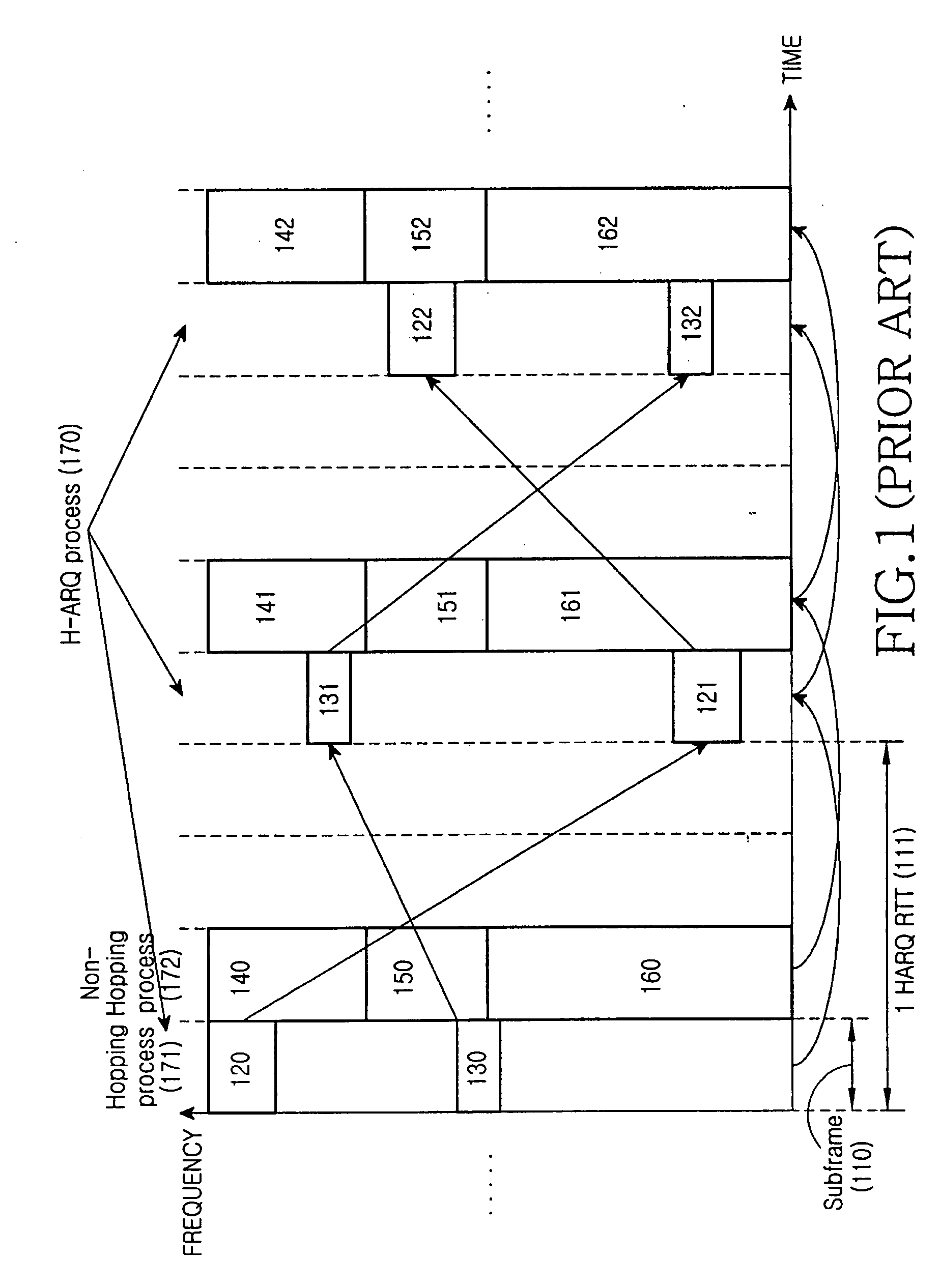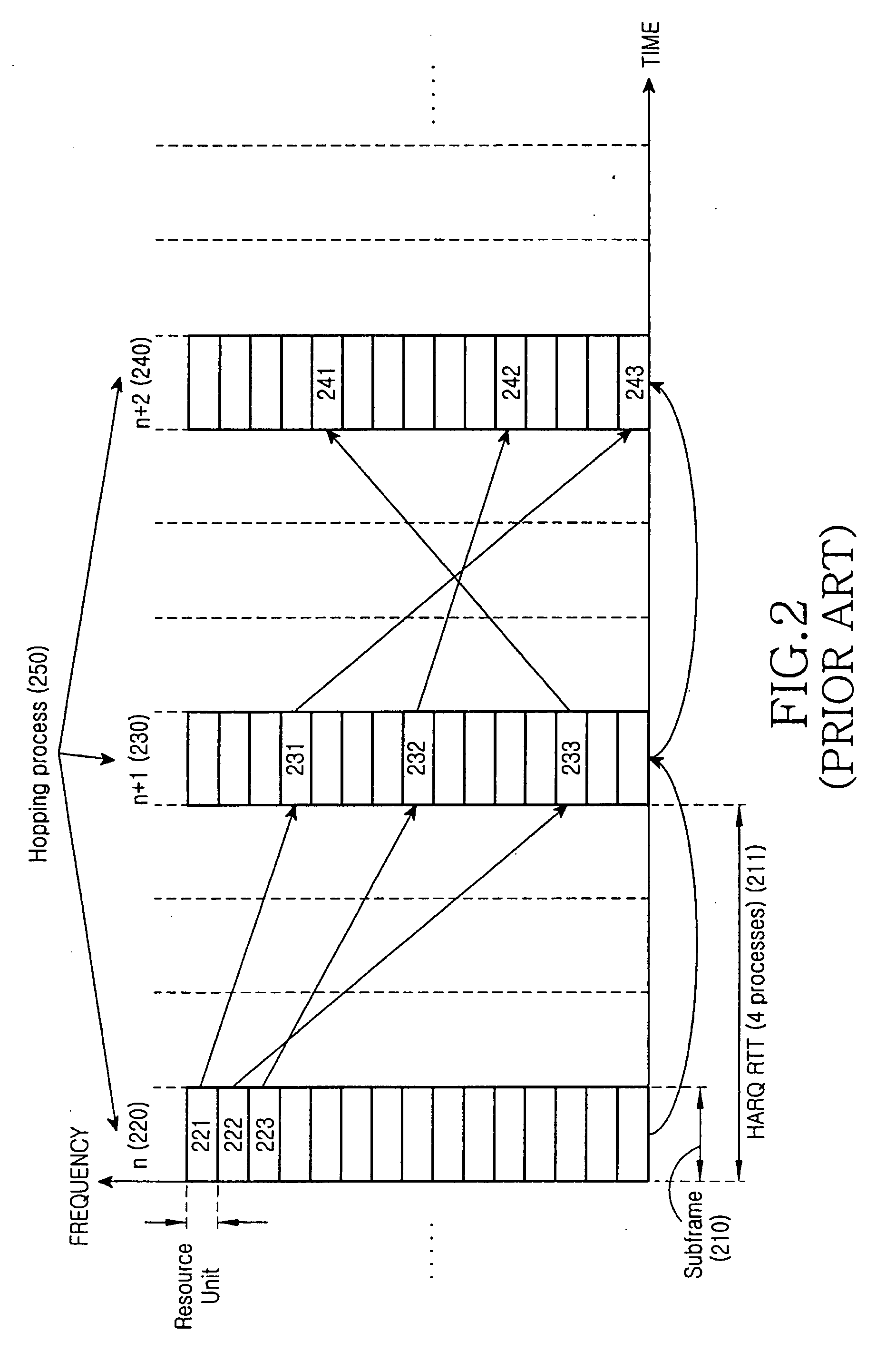Method and apparatus for allocating frequency resources in a wireless communication system supporting frequency division multiplexing
requency division multiplexing technology, applied in the field of resource allocation in a wireless communication system, can solve the problems of inconvenient real-time traffic, inability to adapt to the traffic of frequency diversity technology, and inability to meet the traffic needs of real-time traffic, so as to prevent collision
- Summary
- Abstract
- Description
- Claims
- Application Information
AI Technical Summary
Benefits of technology
Problems solved by technology
Method used
Image
Examples
embodiment 1
[0096]FIG. 3A illustrates a node tree structure for frequency resource allocation in a wireless communication system according to Embodiment 1 of the present invention.
[0097] Assume that a basic unit of frequency resource allocation is an RU formed of a set of consecutive sub-carriers in a frequency band, and upper / lower positions of nodes in the tree structure of FIG. 3A are defined as levels 0-4 LEVEL 310. In FIG. 3A, when nodes belonging to the lowermost level 4 are identical to the basic frequency resource RU in the 5-level node tree, 8 nodes i0,0,0,0, i0,0,0,1, i0,0,1,0, i0,0,1,1, i0,1,0,0, i0,1,0,1, i0,1,1,0, and i0,1,1,1 belonging to the level 3 each correspond to 3 consecutive RUs; 4 nodes i0,0,0, i0,0,1, i0,1,0, and i0,1,1 belonging to the level 2 each correspond to 6 consecutive RUs; 2 nodes i0,0, and i0,1 belonging to the level 1 each correspond to 12 consecutive RUs; and finally, a node i0 in the uppermost level 0 corresponds to 24 consecutive RUs, which are resources o...
embodiment 2
[0115]FIG. 5 illustrates a node tree structure for frequency resource allocation in a wireless communication system according to Embodiment 2 of the present invention.
[0116] Referring to FIG. 5, definitions will be given of general formulae for frequency allocation at an arbitrary time when the system allocates resources in a manner of the faired node tree and transmits data by hopping an allocated frequency band according to a given hopping pattern. As shown in FIG. 5, LEVEL 510 of the node tree are defined as levels 0 to L, the number of nodes belonging to nodes of the same upper level in an lth level (where l is an integer between 0 and L) is defined as Nl, and the number of RUs belonging to one node in an lth level is defined as Rl. According to the definition of the faired node tree, Nl and Rl are identical in the nodes belonging to a particular level, and for Embodiment 1, the Nl and Rl values in each level can be defined as Equation (6).
N0=1, N1=2, N2=2, N3=2, N4=3,
R0=24, ...
embodiment 3
[0122] Embodiment 1 or Embodiment 2, assuming the faired node tree, has independently defined {Sl,nl-1,nl}, nl=0, . . . , Nl-1 for each individual level, or according to an upper node belonging to the same level. Embodiment 3, a special case of Embodiment 1 or Embodiment 2, defines a common hopping pattern according to the number of nodes belonging to nodes of the same upper level. In Embodiment 1, because Nl=2 in levels 1-3 and Nl=3 in level 4, the definition given as Equation (1) is assumed to use a common pattern defined as Equation (11). That is, in levels 1, 2 and 3, a first node among lower nodes has a hopping pattern fixed to {0,1,0,1} and a second node has a hopping pattern fixed to {1,0,1,0}.
S0,0(n,n+1,n+2,n+3)=S0,0,0=S0,0,0,0={0,1,0,1},
S0,1(n,n+1,n+2,n+3)=S0,0,1=S0,0,0,1={1,0,1,0},
S0,0,0,0,0(n,n+1,n+2,n+3)={0,1,2,0} (11)
[0123] Contrary to the time-based hopping operation when the hopping pattern of Equation (1) is used, a hopping operation of FIG. 6 when a common hopp...
PUM
 Login to View More
Login to View More Abstract
Description
Claims
Application Information
 Login to View More
Login to View More - R&D
- Intellectual Property
- Life Sciences
- Materials
- Tech Scout
- Unparalleled Data Quality
- Higher Quality Content
- 60% Fewer Hallucinations
Browse by: Latest US Patents, China's latest patents, Technical Efficacy Thesaurus, Application Domain, Technology Topic, Popular Technical Reports.
© 2025 PatSnap. All rights reserved.Legal|Privacy policy|Modern Slavery Act Transparency Statement|Sitemap|About US| Contact US: help@patsnap.com



